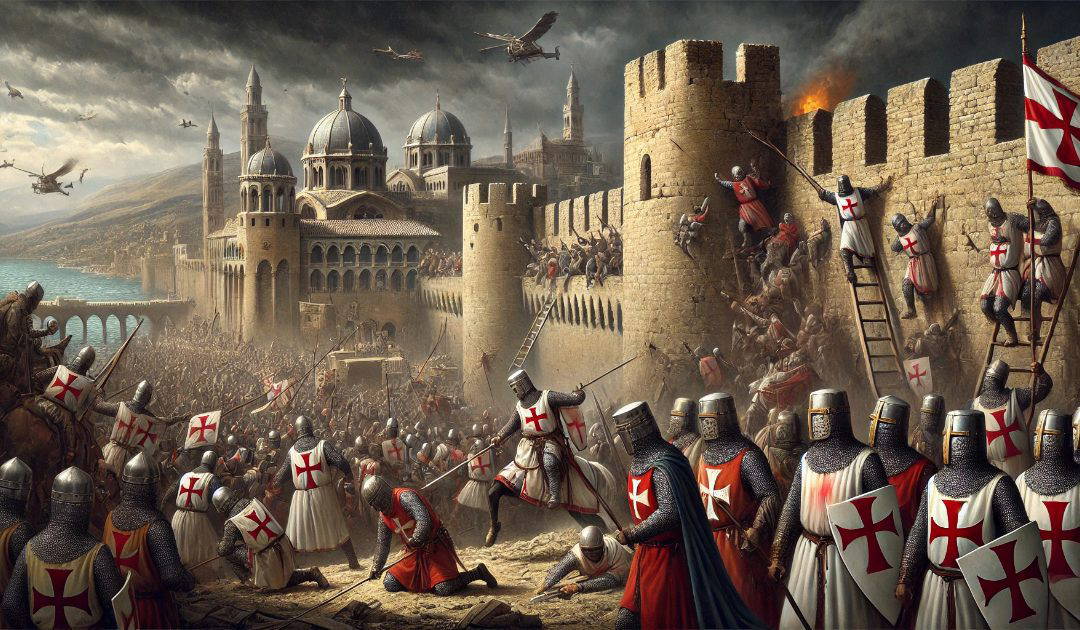There was a breakthrough in the Siege of Antioch on the 2nd of June, 1098. The Siege of Antioch, a pivotal episode during the First Crusade, is as fascinating in its complexity and strategic importance as it is in the sheer audacity of its execution. Taking place from the 21st of October, 1097, to the 28th of June, 1098, this siege marked a crucial passage for the Crusading armies on their arduous journey to reclaim Jerusalem from Muslim control. This event remains a testament to the determination, resourcefulness, and often ruthless nature of medieval warfare.
The First Crusade, initiated by Pope Urban II in 1095, aimed to liberate the Holy Lands and protect the Byzantine Empire from the advancing Seljuk Turks. The crusading armies, composed of knights and peasants from Europe, set off on their quest, enduring numerous hardships along the way. By the time they reached Antioch, a key strategic city in modern-day Turkey, the crusaders were weary yet resolute. Antioch stood as a formidable fortress, commanding the route to Jerusalem and the surrounding region.
The city was an architectural marvel of its time, surrounded by formidable walls that stretched over 12 kilometres and dotted with over 400 towers. These defences, coupled with the city’s strategic location between the Orontes River and the mountains, made it a daunting target. The city’s governor, Yaghi-Siyan, had fortified it further, anticipating the crusaders’ arrival.
When the crusaders arrived at Antioch in late October, they faced the harsh realities of a protracted siege without sufficient supplies. The city’s defenders used the terrain to their advantage, aided by reinforcements from Muslim principalities. Initially, the Crusaders attempted to blockade the city, cutting off supply routes, but the siege was arduous and slow-moving.
As winter set in, the besiegers suffered from cold, hunger, and disease. Their situation was dire, leading to desertions and a decline in morale. Even so, the leadership, including figures like Bohemond of Taranto and Raymond IV of Toulouse, remained determined. They utilised diplomatic strategies, seeking support from neighbouring Christian enclaves and maintaining their position despite the grim conditions.
A critical turning point came in the spring of 1098 when the Crusaders received reinforcements and supplies, bolstering their resolve. The siege intensified as Bohemond devised a cunning plan to breach Antioch’s formidable defences. He negotiated with an Armenian guard named Firuz, who controlled one of the towers, agreeing to let the Crusaders enter in exchange for rewards. The plan was risky but represented one of the earliest examples of espionage and intrigue during the crusades.
On the 2nd of June, 1098, the Crusaders successfully infiltrated Antioch, leading to fierce street battles within the city. Despite their perceived victory, their triumph was short-lived. Almost immediately, they were besieged themselves by a massive relief army led by Kerbogha of Mosul. Trapped inside the walls of Antioch, the Crusaders faced annihilation.
The turning point in this desperate situation came with the discovery of the Holy Lance, supposedly the spear that pierced Christ’s side during his crucifixion. This relic, found by Peter Bartholomew, bolstered the flagging morale of the Crusader forces. Believing it to be a sign of divine favour, the Crusaders rallied and prepared for a counterattack.
On the 28th of June, 1098, the Crusaders launched a surprise assault on Kerbogha’s forces. Despite being heavily outnumbered, the Crusaders’ audacity and belief in their cause led them to victory. Kerbogha’s army panicked and retreated, leaving the Crusaders as the unlikely victors of the siege.
The capture of Antioch was a monumental success for the Crusaders, establishing a crucial foothold in the region. However, it also exposed the deep divisions and rivalries within the Crusader ranks, as arguments over the control of the city ensued. Bohemond eventually claimed Antioch for himself, setting the precedent for European principalities in the Levant.

